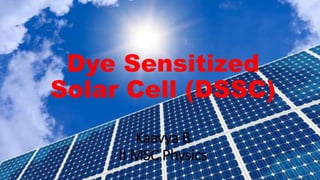
Dye sensitized solar cells
- 1. Dye Sensitized Solar Cell (DSSC) Kaavya B II MSC Physics
- 2. Outline •What is DSSC? •Principle •Construction •Components explanation •Working •Advantages •Disadvantages •Facts
- 3. What is DSSC? •Dye sensitized solar cells also referred as dye sensitized cells are an efficient type of thin – film photovoltaic cell. •These cells convert any visible light into electrical energy. •It was invented by Michael Gratzel in 1988.
- 4. Principle •The mechanism of dye solar cells is based on the photo-electrochemical processes.
- 5. Construction •Transparent & Conductive substrate •Working electrode •Dye (sensitizer) •Electrolyte •Counter electrode are the five key components for a DSSC.
- 6. DSSC Structure DSSC consists of two electrodes, working electrode made up of nano crystalline TiO2 soaked with a dye and sealed to counter electrode (Pt) soaked with a thin layer of electrolyte with the help of a hot melt tape to prevent the leakage of the electrolyte.
- 7. 1. Substrate •DSSC’s are constructed with 2 sheets of conductive transparent films which help a substrate for the deposition of the semiconductor and catalyst acting also as current collectors. •It must have 80% of transparency . •It must have high electrical conductivity.
- 8. Substrate •FTO or ITO are usually applied as a conductive substrate in DSSC. •The conductive film must have a low electric resistance of 10 -20 Ω per square at room temperature.
- 9. 2. Working Electrode •It is prepared by depositing a thin layer of oxide semiconducting materials such as TiO2 on a transparent conducting glass plate made of FTO or ITO. •After soaking the film within the dye solution, the dye gets covalently bonded to the TiO2 surface.
- 10. Working Electrode •Due to the highly porous structure and the large surface area of the electrode, high number of dye molecules get attached on the nano crystalline TiO2 surface, and thus light absorption at the semiconductor surface increases.
- 11. 3. Photosensitizer or Dye •It is responsible for the maximum absorption of the incident light. •They should be able to absorb light at all wavelengths below 920 nm. •Most commonly used dyes are ruthenium based, organic dyes and natural dyes.
- 12. Dye •The dye should be luminescent. •To avoid the aggregation of the dye over the TiO2 surface co – absorbents like phosphoric acid, carboxylic acid group etc., were inserted between the dye and TiO2
- 13. 4. Electrolyte •It facilitates the transport of charge between the working electrode and counter electrode. •The ideal electrolyte solvent must have low viscosity, negligible vapor pressure, high boiling point and high dielectric properties.
- 14. Electrolyte •The most common electrolyte is a liquid electrolyte containing the redox couple iodide/ triiodide. •The chosen electrolyte should be non – corrosive with DSSC components. •It should be able to permit fast diffusion of charge carriers.
- 15. 5. Counter Electrode •It is prepared by using platinum or carbon. •It catalyzes the reduction of I- /I- 3liquid electrolyte. •Platinum is used as a counter electrode because of its higher efficiencies.
- 16. Working of DSSC •The working principle of DSSC involves light absorption, charge separation and charge collection. •Under sunlight illumination, the dyes will absorb photons (light) and these photons become excited. S hν S*
- 17. Working •The absorbed dye molecules will inject electrons into the TiO2 working electrode and thus become oxidized. S* S+ + e- •Charge separation is attained across the semiconductor interface where an electron is located in the TiO and a hole is located
- 18. Working in the oxidized dye molecule. •The electrons will then percolate through the porous network of TiO2 and eventually reach the back contact of the working electrode where charge collector and charge extraction occur.
- 19. Working •The extracted charge can perform electrical work in the external circuit and eventually return to the counter electrode where reduction of the redox mediator takes place. •The liquid redox electrolyte completes the circuit by reducing the oxidized dye.
- 20. Image
- 21. Advantages •Optimized performance •Higher temperature performance •Ecologically friendly •Higher efficiency
- 22. Disadvantages •Platinum and ruthenium are limited resource and are expensive. •Co – sensitizer is required to optimize the performance of DSSC.
- 23. Facts !!! •DSSC technology arose from the concept of “artificial photosynthesis”. •It replicates the ability of plants to turn sunlight into useful energy, where in chlorophyll is replaced by a light absorbing dye in case of DSSC.